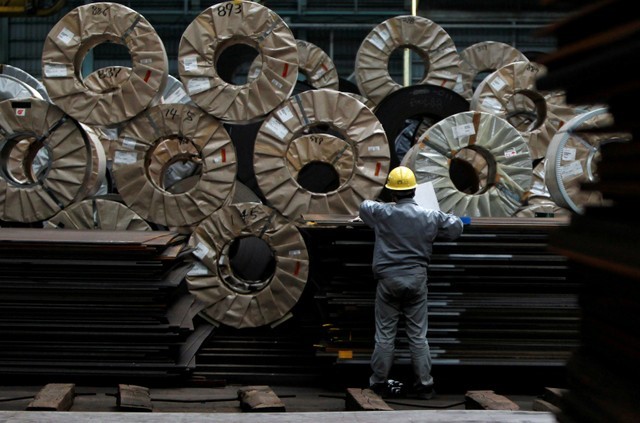
FILE PHOTO – A worker checks steel coils and steel sheets at a distribution warehouse in Urayasu, east of Tokyo April 19, 2012. REUTERS/Toru Hanai/File Photo
June 29, 2018
By Stanley White
TOKYO (Reuters) – Japan’s industrial output declined far less than expected last month and the jobless rate hit its lowest in over 25 years in a sign of a gradual economic recovery from a slump in the first quarter, though risks to the outlook has increased from U.S. trade protectionism
A bitter trade dispute between the United States and major economies, including Japan’s big export market China, has unnerved investors and policy makers worried the tariff spat could deal a body blow to the global economy.
How well Japan’s manufactures perform will likely be key to the growth outlook, and so Friday’s data showing industrial output fell 0.2 percent month-on-month in May is not all bad news, coming off better than the median forecast for a 1.1 percent decline. Output rose 0.5 percent in April.
Manufacturers surveyed by the Ministry of Economy, Trade and Industry expected output to rise 0.4 percent in June and 0.8 percent in July in an encouraging sign for capital expenditure.
Economists expect output to continue to rise gradually as overseas economies gather strength, though the trade friction with the United States poses the biggest risk to the outlook.
“It is safe to say the economy is on the recovery path,” said Hiroaki Muto, economist at Tokai Tokyo Research Center.
“As long as the level of inventories comes down there should not be any major problems. I am worried about trade protectionism, but it is hard to predict what will happen.”
The jobless rate fell in May to 2.2 percent, the lowest in over 25 years as companies grappled with labor shortages. The jobs-to-applicants ratio, a measure of demand for workers, rose to 1.60 from 1.59 in April to the highest since January 1974.
Japan’s economy is expected to rebound in the second quarter from a contraction the first quarter that ended the longest growth streak since the 1980s bubble economy.
The smaller-than-expected decline in output and the tightening labor market may offer some encouragement for the Bank of Japan.
A tight labor market should put upward pressure on wages, which suggests that inflationary pressure will eventually build.
The BOJ will conduct a quarterly review of its projections at a rate review in July and will examine whether recent weakness in consumer prices is temporary.
The May output decline was driven by a 6.9 percent drop in production of vehicles and a 1.9 fall in output of steel used in construction, the data showed.
Output of cars fell as some auto makers stopped production lines during Japan’s annual Golden Week holiday during the first week of May, a government official told reporters.
Inventories rose 0.6 percent in May, following a 0.6 percent decline in the previous month, due to higher stocks of steel, motorcycles, and semiconductors, the data showed.
(Reporting by Stanley White; Editing by Eric Meijer & Shri Navaratnam)
